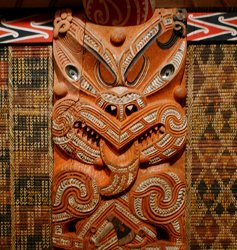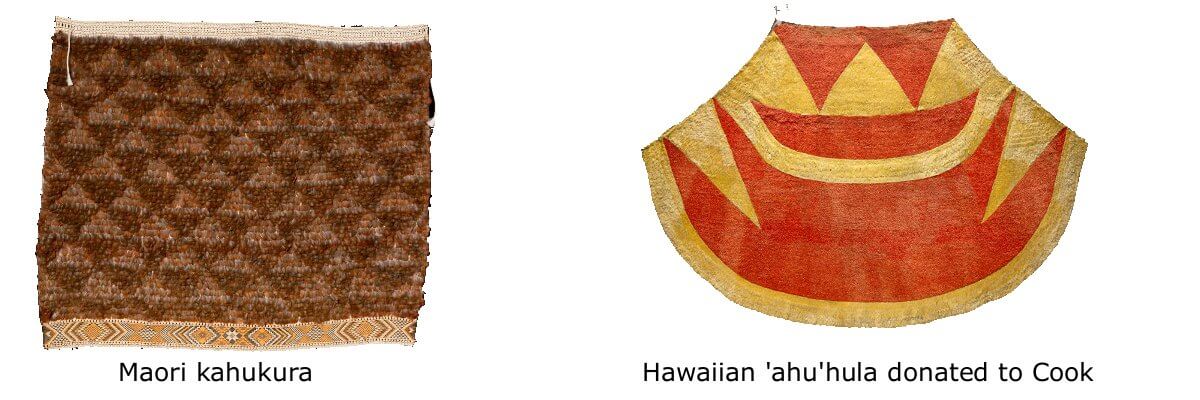
The Traditional Maori Colour Palette
Colour significance, like any custom or ritual, may differ locally or regionally, as different materials could make certain colors more common than others, but some key ideas are widely shared.
Traditional Tattoo Colours: Moko (traditional tattoos) for example were traditionally blue-black or blue-green, depending on the materials used for pigmentation, which varied. Resins like kauri gum and awheto (vegetable caterpillar) were burnt to obtain the required colour.
Southern tribes did use other colours obtained from clays (like aumoana, or blue clay), which often appear in kowhaiwhai and on poupou and maihi (decorations on the rafters, walls and bargeboards of traditional meeting houses).
Other traditional colours include:
- kura: scarlet, a bright red
- kiwikiwi: grey
- pukepoto: dark blue
- kakariki: green
- karaka: orange
- kikorangi: blue
- kowhai: yellow
Maori natural pigments never gave overly bright or garish colours; their designs reflected the colours of the earth. Taniko weaving introduced blues and greens as a modern development after missionaries brought dyed wool.
The Three Creation Colours: Black, Red, and White
The Tino Rangatiratanga flag, which uses black, white, and red, represents unity in the creation (these are the same colours used for the TattooTribes logo). While Te Kara was officially recognized as the Maori flag in 1834, Tino Rangatiratanga (Sovereignty) appears in the Maori version of the Treaty of Waitangi of 1840.

Black (Pango, Mangu)
It represents Te Korekore, the realm of Potential Being, the darkness and the shapeless Void from where all things emerged. It symbolizes the male principle.
Red Ochre (Kokowai)
It represents Te Whei-Ao, the realm of Coming into being, and the female principle. It is an active principle, as opposed to black which is passive. It is the color of the blood found in veins, and it is the color used to represent the land, the Earth Mother Papatuanuku.
White (Ma)
It represents Te Ao-Marama, the realm of Being and light, providing the connecting force between red and black. The shape of the unfolding koru (spiral/loop) often underlines this idea of new life coming into being.
The three colors together symbolize unity between the world of spirits, of people, and of nature, a concept widely spread in Polynesia (similar to the Hawaiian lokahi symbol).
Chiefly Colours and the Proverb of Unity
Whero (orange red), or kura (scarlet), were considered chiefly colours, associated with mana (spiritual power/prestige), tapu (sacredness/spiritual restriction), and high rank.
These colours, along with yellow, were also highly valued in Hawaii, where they had a similar meaning and were used for the magnificent feathered cloaks ('ahu'ula) of the highest chiefs.

A Maori proverb says: "Ma whero, ma pango, ka oti te mahi" ("With red, with black, the work will be done").
This proverb has two main interpretations:
- Social Unity: It means both chiefs (red, from the mixture of shark oil and red ochre smeared on their bodies) and commoners (black) are equally important to achieve a goal.
- Spiritual Balance: Red and black relate to the sacred (tapu) and the common (noa), meaning that to complete a task properly, both its spiritual and physical aspects must be considered.
Usage Example: Whangarei Mural
This design, created by Dr Benjamin Pittman as a mural to improve southern access into the city of Whangarei, demonstrates the use of these colors and symbols:

The mural uses pango (black) for the male principle, kokowai (red ochre) for the female principle, with white and cream providing the connecting force.

The first design element represents two stylised kukupa (native wood pigeon, a key ancestor's name for Te Parawhau ki Tai), symbolising renewal and resilience.

The next element is the patiki (flounder), a symbol of abundance in food. It is also a reference to Te Atakura, from whose breasts flowed the symbolic waiu (milk of plenty).

The third and fourth design elements represent whakapapa (genealogy) and linkages between all things earthly and spiritual, animate and inanimate-a genealogy of inter-connectedness.

The next elements focus on people, integrating niho taniwha (teeth of taniwha), representing chiefly power, and poutama (the stairway to knowledge).

The final element is again patiki, summarising all and pointing to continuation, betterment, effort and infinity, while the triangular design below it is maungatihi symbolising the ancestral mountains as Te Parawhau.
You can visit the website dedicated to the Maori chief Patuone to learn more about Maori history and culture.

